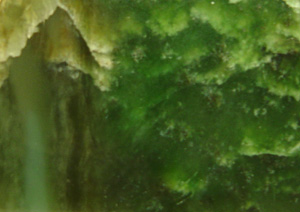Bowenite

Bowenite is a hard, compact variety of the serpentinite species antigorite found in several places throughout the world, notably in the US state of Rhode Island where in 1966 it was adopted as the state mineral.[1] Other known sources include Afghanistan, China, New Zealand and South Africa.
Bowenite was named by James D. Dana in 1850 for George T. Bowen, who analyzed it in 1822. It typically ranges in color from a dark forest green to a light olive green with shades approaching yellow.
Historically, deposits were discovered in very small quantities and sizes, but a larger deposit was discovered in South Africa in the latter part of 1989. The largest known artifact made of bowenite is a carving approximately 14 inches in size, which resides in the National Museum of China.
Bowenite sources in China are situated in the Soochow region, which accounts for its also being known as Soochow jade.
In New Zealand, the Māori consider bowenite a form of pounamu along with nephrite jade, and use it for tools, weapons and ornaments.
Bowenite has been used as a substitute for nephrite jade, and in most cases, the only way to distinguish between the two gemstones is to test the specific gravity.
